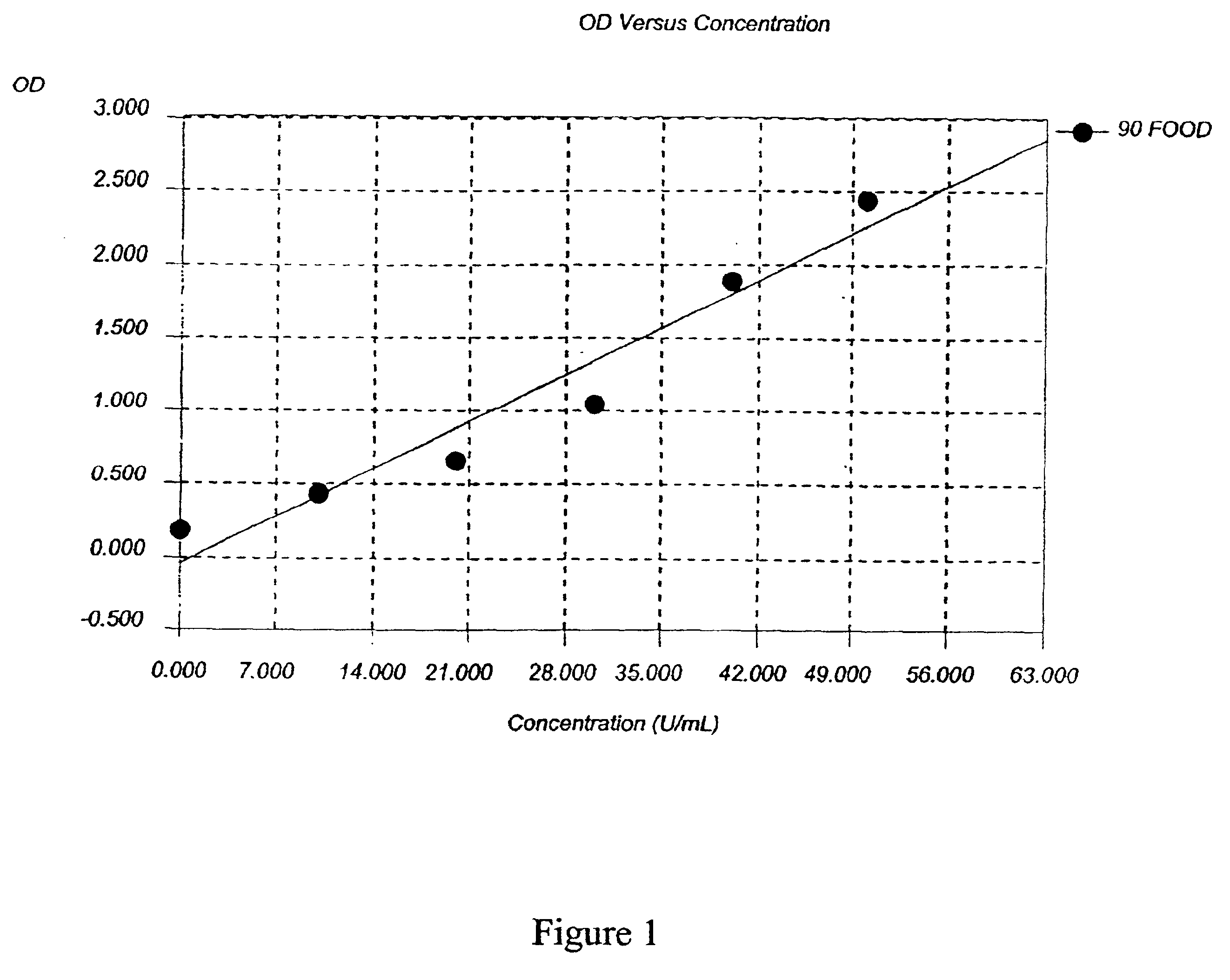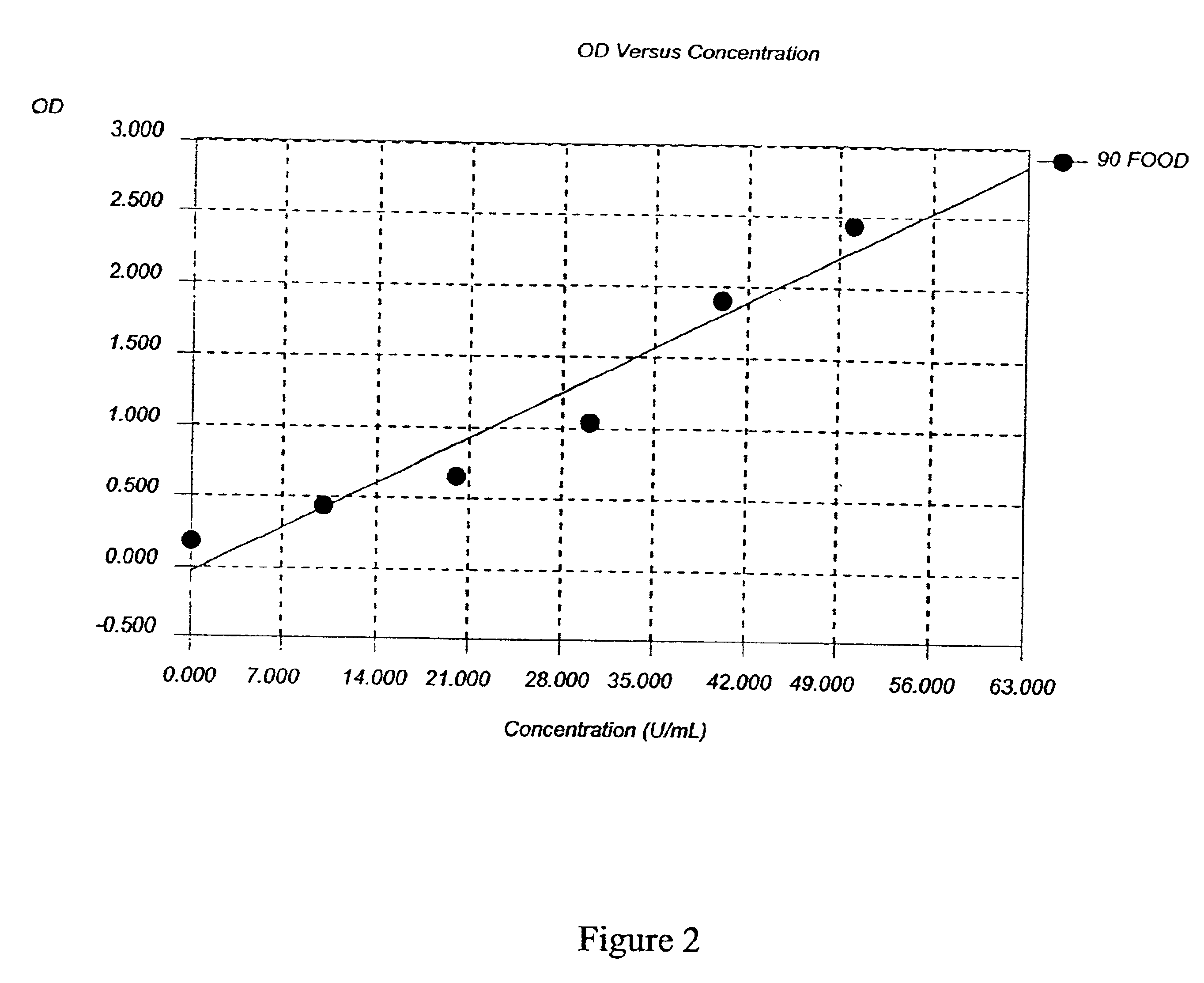Saliva test for detection of food allergy and intolerance
- Summary
- Abstract
- Description
- Claims
- Application Information
AI Technical Summary
Benefits of technology
Problems solved by technology
Method used
Image
Examples
example 1
Analytical Methods for Identification and Characterization of Food Allergens
The isolation of proteins and glycoproteins in a native form is the prerequisite for the extraction from foodstuffs. A suitable method for food is the low temperature extraction developed by Clements (24). The foodstuffs are homogenized with cold acetone at −40° C. to separate the phenolic ingredients, which can cause a loss of allergenic activity by enzymatic reactions. The precipitated proteins are washed, lyophilized, and extracted with phosphate buffered saline. The contents of the protein extracts are measured by the method of Bradford (25).
The separation of the different proteins from food is carried out by applying chromatographic and electrophoretic methods. The electrophoretic methods include sodium dodecylsulfate polyacrylamide gel electrophoresis (SDS-PAGE) and isoelectric focusing (IEF). In the case of SDS-PAGE, the separation of the proteins is carried out according to their molecular weight. On...
example 2
Test for Dietary Antigens
The immunoassay can use patient saliva, collected in a sterile tube. Saliva can be stored frozen for up to six months at a laboratory, such as Immunosciences Laboratory, in order to be available for testing with samples as necessary to observe the usefulness of treatment.
The purified antigens were prepared according to Example 1 and were immobilized by attachment to a solid surface, such as a microtiter plate. Defined above, the dietary antigens are derived from the following general groups: milk and milk products; eggs and egg products; meat and meat products; fish, mollusks, and crustaceans and their products; oils, fats, and their products; grains and grain products; pulses, seeds, kernels, nuts, and their products; vegetables and vegetable products; fruits and fruit products; sugar, sugar products, chocolate products, and confectionary; and spices and herbs. Test tubes or microtiter plate wells were coated with about 1-10 micrograms of antigens in carbon...
example 3
Analysis of Results
Results were analyzed as a panel. The dietary antigens were selected from American cheese, cheddar cheese, cottage cheese, cow's milk, goat's milk, Swiss cheese, yogurt, eggs, beef, chicken, pork, turkey, clam, codfish, crab, halibut, lobster, oyster, salmon, sardine, scallop, shrimp, sole, trout, tuna, butter, barley, buckwheat, malt, oat, rice, rye, wheat, almond, cashew, coffee, cola nut, lima bean, millet, peanut, pinto bean, safflower seed, sesame, soybean, sunflower seed, walnut, broccoli, cabbage, carrot, cauliflower, celery, corn, cucumber, eggplant, green pea, green pepper, iceberg lettuce, mushroom, onion, potato, spinach, squash, string bean, sweet potato, tomato, apple, avocado, banana, blueberry, cantaloupe, grape, grapefruit, lemon, olive, orange, peach, pineapple, strawberry, chocolate, honey, chili powder, cinnamon, garlic, mustard seed, parsley, tea, Baker's yeast, and Brewer's yeast.
Calibration graphs were obtained from the optical density values...
PUM
 Login to View More
Login to View More Abstract
Description
Claims
Application Information
 Login to View More
Login to View More - R&D
- Intellectual Property
- Life Sciences
- Materials
- Tech Scout
- Unparalleled Data Quality
- Higher Quality Content
- 60% Fewer Hallucinations
Browse by: Latest US Patents, China's latest patents, Technical Efficacy Thesaurus, Application Domain, Technology Topic, Popular Technical Reports.
© 2025 PatSnap. All rights reserved.Legal|Privacy policy|Modern Slavery Act Transparency Statement|Sitemap|About US| Contact US: help@patsnap.com



